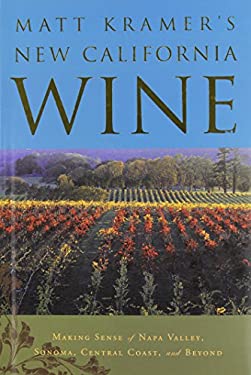Book Review:
New California Wine: Making Sense of Napa Valley, Sonoma, Central Coast, and Beyond
Written by Matt Kramer
2004 publication, 1st Edition, 399 pgs
After reading James Laube’s book on California wines, I dug into fellow Wine Spectator coreligionist Matt Kramer’s book on the same topic. His book is also an older one, and the author has prior works on the same subject, but has named them differently, so I think his intent is that this 2004 volume is NOT a formal 2nd edition to his 1992 Making Sense of California Wine. In the thirty years I’ve been enjoying this hobby, I have rarely ever heard anyone say ‘oooh this a XX scored Matt Kramer wine’ so my perception of him has generally has been that he was a prose centric columnist for the WS, rather that a score / tasting note / promotional machine. That’s not a pejorative – I love reading work from observers who focus on the essential story of an estate and the gestalt of the vintner – versus trivialities like whether a bottling is more hibiscus or honeysuckle, at some instant.

The early parts of the book set the stage, covering ~70 pages, and touch upon high level issues like planting shifts, the new attention to soil (versus the old degree days slavishness), the dominance of marquee regions like Napa (and Sonoma to a lesser extent), and the difference between ‘wine’ and fine wine. Kramer is blunt about how the latter category is capital intensive - requiring older vineyards, high quality equipment, labor intensive practices, and then patience before monetizing. There is a candid discussion of how economics are altering what is made, over what might be the best for any climat. In a market economy, it is difficult to fight prices, especially for producers who don’t have the wherewithal to pursue passion projects like obscure varietals, or styles that are out of fashion, like dessert wines. The impact of land prices in the glamour AVA on the wines is a constant theme.
Kramer’s views on AVA are laid out: the US system doesn’t really mean much. For the Old World collector expecting AOC types of protections / typicite based on where the wine is from, the collection of AVA constantly created, and not always even used on the labels, isn’t going to be any guarantor of quality or taste profile.
This first overview / general section of the book is filled with nuances about California’s development that would still be educational, interesting even to long time followers of the local scene. They preface the meat of the book that follows.
Afterwards, Kramer digs into the key wine making zones and key producers. The most important takeaway is how the author emphasizes the importance on authenticity of place where grapes comes from. If a wine doesn’t have a ‘somewhereness’ that shines through, no matter how delightful it might otherwise be, it will be noted. He is very pointed in calling out how producers that have constantly shifted AVA, and other nomenclature, usually not in the consumer’s interest, but rather so that cheaper grapes can be folded into a branded wine that has earned a good reputation.
In each geographical section, it closes with producers that are worth seeking out. These are more candid than a reader might expect (the book was published by a different press than the WS affiliate that handled Laube’s one) and prominent disappointments are called out. Of course some of the up and comers (mentioned in 2004) have ended up being flash in the pans with the fullness of time, but that’s a helpful reminder when looking at all the ‘hot / new / fashionable’ bottles competing for dollars and rack space today. Many of long established - and commercial - wineries that I continue to enjoy do NOT gather plaudits under Kramer’s worldview. For example, at least circa 2004, for mass market Costco staple BV he’s cool towards everything except the GdL bottling, while at least acknowledging their history.
There are some estates of note, that get truly ripped in his assessments e.g Far Niente. One of his critiques of their chardonnay is that its assembled from 60 different parcels, which probably violates all the somewhereness rules of great wines. Another example: Rombauer’s lineup is compared to a Top 40 radio station, playing what is popular, versus what is ‘good’. I could go on, but there are plenty of headliner names which get tepid overviews.
I live in the region and am mostly familiar with areas, but my one complaint about the book, would be that its lacking in maps/visuals. Given the focus on ‘place’ the author has, I think depictions of those would have helped. Perhaps the book is targeted to knowledgeable readers who would not need those, or the publisher was not well equipped to include maps/plates, but in any case I feel that gap holds the book back. Still, overall, I enjoyed the book and learned plenty. It’s an easy, brisk read that has useful guidelines, even if one might not agree with each and every one. I am more accepting of popular styled, commercial whites than the author might be, since our consumption of those is not an oenophile, academic effort, but happy poolside or kitchen quaffing. Sure, some material is now dated and less relevant, but if one wants to understand the ‘somewhereness’ of Golden State wine, this is worth a couple hours and bucks. I’d give it a A-, and be receptive to reading other books by Kramer, although I have so many books in my backlog, that I won’t proactively seek them out on the internet. I’d observe the author’s writing is in the Hemingway abbreviated style: terse, direct, clear and well edited for conciseness. Most wine material I read are not presented this way.
[https://www.amazon.com/Matt-Kramers-New-California-Wine/dp/0762419644](link to the book) that is NOT an affiliate pointer. New copies are on Amazon for $13, secondhand copies change hands for $2.
